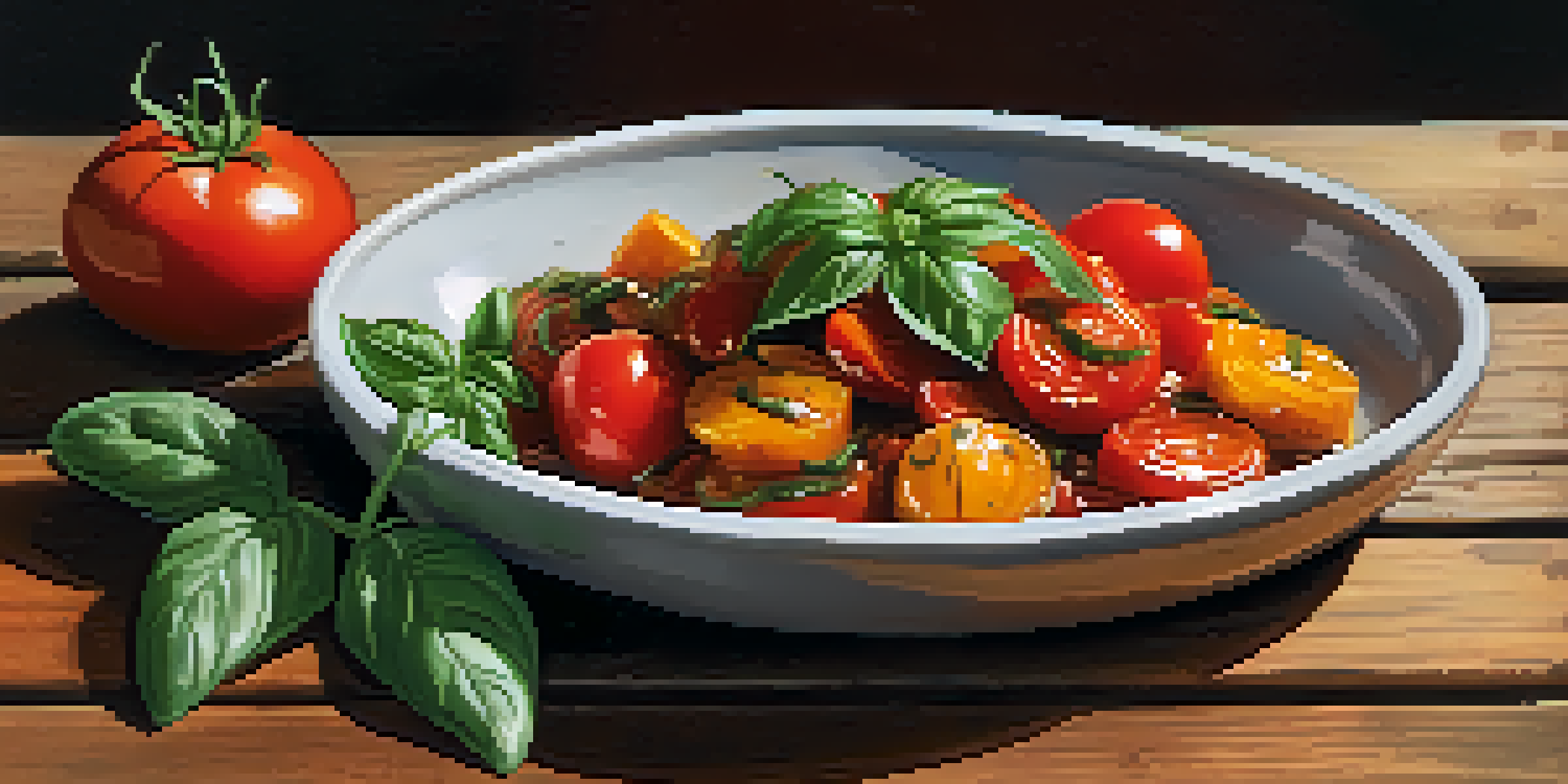Flavor Balancing: Techniques for Culinary Perfection

Understanding Flavor Profiles: The Building Blocks of Taste
Flavor profiles are the foundation of any dish, encompassing the balance of sweet, sour, salty, bitter, and umami. By understanding these basic tastes, you can create dishes that resonate with your palate. For instance, a well-prepared tomato sauce combines the acidity of tomatoes (sour) with the sweetness of onions and carrots, creating a harmonious blend that elevates the dish.
The secret to good cooking is, first, having a good resource in your pantry, and second, knowing how to balance flavors.
Each ingredient you choose contributes to this profile, influencing how flavors interact. A pinch of salt can enhance sweetness, while a splash of vinegar can brighten up heavy dishes. Think of flavor profiles as a palette for a painter—each color (or flavor) plays a critical role in the overall masterpiece.
As you experiment with different combinations, remember that balance is key. A dish that's overly salty can overpower, while a lack of seasoning can render it flat. Strive for a combination that excites the taste buds and invites your diners to savor every bite.
The Role of Acidity: Brightening Up Your Dishes
Acidity is often the unsung hero in flavor balancing, adding brightness and depth to your meals. Ingredients like lemon juice, vinegar, or tomatoes can transform a dull dish into something vibrant and exciting. For example, a drizzle of balsamic vinegar over roasted vegetables can elevate their natural sweetness and create a refreshing contrast.

When using acidic components, it's essential to consider the overall flavor balance. Too much acid can lead to an unpleasant sharpness, so start with a small amount and gradually add more as needed. This approach allows you to maintain control over the dish's flavor profile.
Flavor Profiles Define Dishes
Understanding the balance of sweet, sour, salty, bitter, and umami is essential for creating delicious and harmonious dishes.
Incorporating acidity not only enhances taste but also aids in digestion, making your meals more enjoyable. So, don’t shy away from that splash of citrus or vinegar; instead, embrace it as a tool for culinary perfection.
Sweetness: Balancing Bitter and Spicy Flavors
Sweetness is a powerful tool in the kitchen, particularly when it comes to balancing bitter or spicy flavors. A little sugar can tone down the heat in a chili dish or counteract the bitterness of greens like kale. This technique can turn an off-putting flavor into a delightful experience, making your meals more appealing.
Cooking is like love. It should be entered into with abandon or not at all.
Consider the classic combination of sweet and spicy in dishes like sweet chili sauce. The sugar helps to mellow the sharpness of the chili, creating a complex yet harmonious flavor. This interplay can also be seen in desserts, where a pinch of salt enhances sweetness, making the dish taste even more indulgent.
When adding sweetness, remember that natural sources like honey or maple syrup can impart a unique flavor profile compared to refined sugars. Experimenting with different sweeteners can lead to exciting discoveries and enhance your culinary repertoire.
Salt: The Essential Flavor Enhancer
Salt is often regarded as the backbone of flavor. It enhances the natural tastes of ingredients and can make a dish sing. Just a sprinkle can bring out the sweetness in tomatoes or the earthiness in mushrooms, transforming a mediocre meal into a culinary masterpiece.
However, it's crucial to use salt judiciously. Too much can overshadow all other flavors and lead to an unpleasant dining experience. A good rule of thumb is to season gradually while cooking, tasting as you go to find that perfect balance.
Acidity Brightens Flavor
Incorporating acidic ingredients like lemon juice or vinegar can elevate the overall taste and freshness of your meals.
Different types of salt, such as sea salt or kosher salt, can also impart varying flavors and textures. By understanding how to utilize salt effectively, you can elevate your cooking and ensure that every dish is perfectly seasoned.
Umami: The Fifth Taste That Complements Everything
Umami, often described as savory, is a flavor that adds depth and richness to dishes. Found in ingredients like mushrooms, soy sauce, and aged cheeses, umami can round out a meal and make it more satisfying. Think of it as the secret ingredient that ties everything together, enhancing other flavors rather than competing with them.
Incorporating umami-rich ingredients can significantly elevate your cooking. For example, adding a splash of soy sauce to a stir-fry not only enhances the overall flavor but also creates an enticing aroma that stimulates the appetite. This is why many chefs consider umami essential in achieving culinary perfection.
Experimenting with umami can open up a whole new world of flavors. Whether through fermented products, broths, or aged meats, incorporating umami can create a well-rounded dish that keeps diners coming back for more.
Texture: The Unsung Hero of Flavor Balancing
While flavor is paramount, texture plays an equally crucial role in the dining experience. The contrast between crunchy and creamy, for example, can elevate a dish and make it more enjoyable. Think about the satisfying crunch of toasted nuts atop a creamy salad; it's this interplay that captivates the palate.
When balancing flavors, consider how texture complements taste. A smooth sauce can enhance the tenderness of meat, while a crisp topping can add excitement to a soft dessert. This balance can make even simple dishes feel gourmet.
Texture Enhances Dining Experience
The contrast of textures, such as crunchy and creamy, plays a crucial role in making dishes more enjoyable and memorable.
Don't hesitate to experiment with different textures in your cooking. Adding a crunchy element to a soft dish can create a delightful contrast, allowing your flavors to shine in new ways.
Culinary Techniques: Methods for Perfect Flavor Balance
Mastering flavor balancing requires a combination of techniques and practices. From sautéing and roasting to braising and marinating, each method can influence the final taste of your dish. For instance, roasting vegetables caramelizes their natural sugars, enhancing sweetness while adding depth.
Another effective technique is layering flavors during cooking. Start with aromatics like garlic and onions, then build upon that foundation with spices and herbs. This method allows flavors to meld together, creating a more complex and satisfying dish.

Lastly, don't underestimate the power of resting. Allowing a dish to sit for a few minutes after cooking can help the flavors develop further, resulting in a more balanced final product. Embrace these techniques to achieve culinary perfection in your kitchen.
Taste Testing: The Final Step in Flavor Balancing
No matter how skilled you are, the final step in achieving perfect flavor balance is taste testing. This process allows you to assess whether the flavors harmonize and whether any adjustments are needed. Always keep a spoon handy and taste as you go; this is where you can make magic happen.
When taste testing, consider the overall balance of your dish. Does it need more acidity, sweetness, or salt? Trust your palate and remember that it's okay to tweak as you go. Even professional chefs continuously adjust their dishes until they achieve the desired result.
In the end, flavor balancing is an art that requires practice and patience. As you refine your skills and listen to your taste buds, you'll find yourself creating dishes that not only taste good but also leave a lasting impression on those who enjoy them.